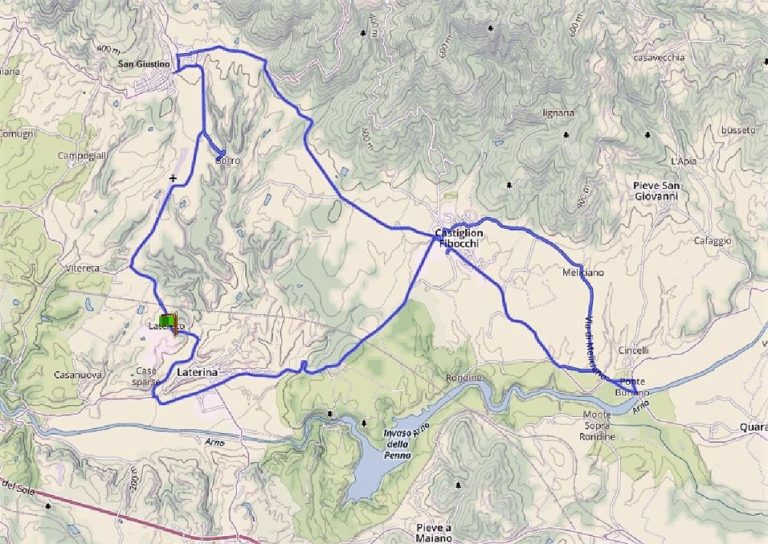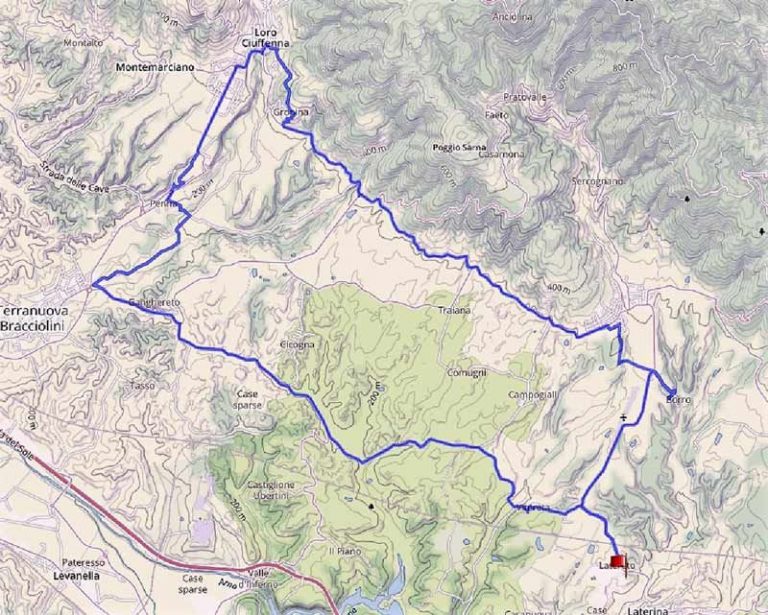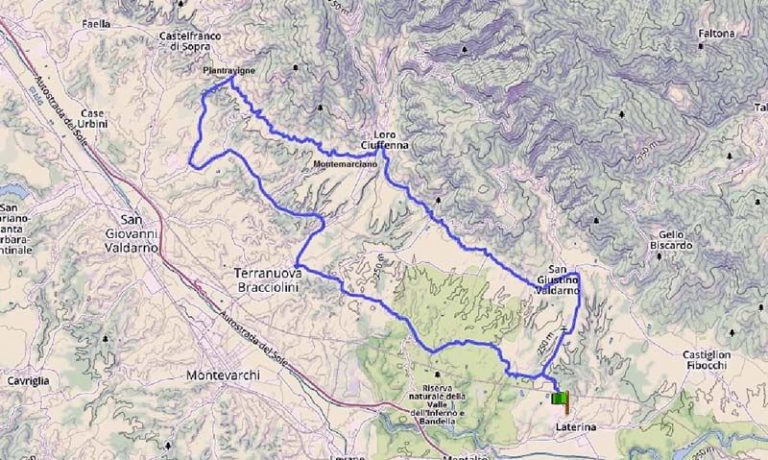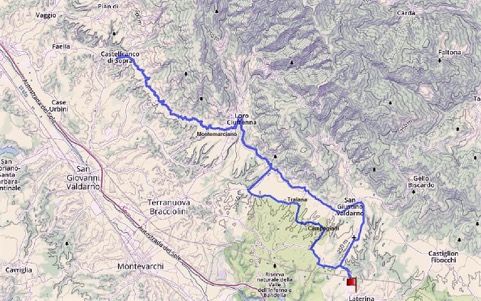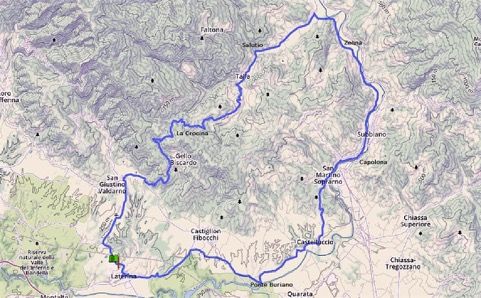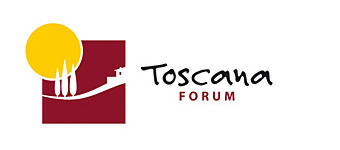The bycicle diaries
Leap onto your bike!
We have created 5 itineraries that differ in difficulty and scope of interest, taking you to lesser-known destinations in this corner of Tuscany, such as Gropina, Loro Ciuffenna, Montemarciano and Talla.
We provide rental bikes for you and your fellow travelers. The daily cost starts at €40/person for a mountain bike and €60/person for an electric bike. Discounts are available for extended rental.
If you wish, you can request a specialized tour guide at a cost of €110 for half a day to be divided among participants or €170 for the full day (maximum number of participants 8).
For reservations and more information, contact us in person or at the WhatsApp contact found in this app. Bike rental requests must be made at least 24 hours in advance.
1st route: Paesaggio
The first itinerary we want to propose concerns the beauty of the landscapes that is possible to visit nearby the holiday house: indeed, this route is called “Paesaggio”, meaning landscape.
It starts from the holiday home Le Fornaci, heading to Il Borro, a picturesque medieval burg surrounded by nature that once was crossed by the roman road Cassia.
From there, we reach San Giustino, a little village on the slopes of the Pratomagno, grown around a wonderful Romanesque church of 13th century.
The next step brings us to Castiglion Fibocchi, a little village in the countryside, passing on the road Setteponti, that connects Arezzo to Firenze.
Following this road, we arrive at Ponte Buriano, a well known bridge painted on the background of the Monnalisa, the famous masterpiece of Leonardo da Vinci. Here is a good place to rest a bit, while you can admire the typical Tuscan coutryside reflecting on the water of the river Arno.
From Ponte Buriano we start to come back, crossing the fields of Meliciano and arriving on the other side of Castiglion Fibocchi. From there, we quickly reach the castle of Laterina, a place full of history, and then again the holiday home.
This itinerary is quite easy and suitable also for beginners, since has not hard uphill. It is 30km long, on asphalt road and has a coefficient of difficulty of 3/10
2nd route: Belle arti
The second itinerary is focused on visiting those places with a strong artistic interest, leading us to name this route “Bellearti”, literally meaning “Beautiful arts”.
This time we take the opposite direction from the previous route, heading to North-West, to go visit other fascinating villages. The first one we find is Vitereta, well known in this area for the production of exquisite wines, that have been awarded many times in last years.
After a bit of uphill and downhill, the road Val d’Ascione will bring us to Terranuova Bracciolini, a former bastion once called Castel Santa Maria. Along this road will be impossible to not notice some particular kind of hills: those are called Balze, a fossil mountain generated by the erosion of the soil, painted by Leonardo da Vinci on the background of the Monnalisa and of the Madonna of the Rocks.
From Terranuova Bracciolini, after a straight road, we arrive to Loro Ciuffenna, a lovely village crossed by the creek Ciuffenna. This place takes its name from the ancient Latin laurus, meaning laurel oak, while Ciuffenna derives from the name Clufennius, probably an important person of many centuries ago. Indeed, this area was inhabited in very distant times: the village is mentioned in the 13th book of Ab Urbe Condita, written by Tito Livio. However, the most important mark had been left by the Etruscan population in Gropina, that is the next step and most important destination of this route. On the top of the hill, we will visit the wonderful Pieve of San Piero, the most important example of Romanesque architecture. Its internal decorations are very unique and particular, but its basement is even more exceptional and mysterious: is possible to admire the ruins of a paleo-Christan church of 5th century.
From Gropina we come back to the holiday home following the road Setteponti, a panoramic road that Leonardo da Vinci walked during his studies about water, passing through San Giustino. We strongly suggest a stop at Il Borro before to arrive to the holiday home.
This route is 36km long and has a difficulty of 4/10, because s not too tiring and long, although it has some uphill to not underestimate.
3rd route: Le Balze
The third route that we are proposing focuses precisely on visiting the unique landscapes that lie a short distance from our holiday home: the Balze.
The first part of the route is quite similar to the previous one, until a few kilometres beyond the diversions from Terranuova Bracciolini, from where we move in the direction of Piantravigne. Along the way, it is possible to admire on several occasions the numerous vineyards, the fields that were once used for the production of tobacco used for the famous Tuscan cigars, and the Balze. These geological formations date back to the third period of the Pliocene, when the large lake that invaded this area began to recede, allowing atmospheric erosion to give rise to these conspicuous furrows made of clay and sandstone with their characteristic shape.
Testimony to the presence of this ancient lake remains today in the bed of the Arno River, which flows in the direction of Florence, and the fossil remains of aquatic mammals, such as archaic forms of tapirs, hippopotamuses, rhinos, elephants, and plants typical of tropical environments visible in the Paleontological Museum of Montevarchi. Leonardo Da Vinci, studying these formations while staying two years on site, postulated those theories that were the basis of today’s knowledge of erosion phenomena.
After Piantravigne, the Setteponti accompanies us with its ups and downs to Montemarciano, a typical village perched on the Balze, where the two arches at either end of the village give way to the famous Buca delle Fate trail.
We return by following the stretch of road that connects Loro Ciuffenna, San Giustino and Casa Vacanze le Fornaci, described in the previous trail.
This route has an intermediate difficulty, classifiable as a 6/10, and has a total length of 46 km.
4th route: Setteponti
The fourth route, called “Setteponti“, is a more linear variation of the previous route.
From Vitereta, we head to the village of Campogialli, an ancient castle that belonged to the Ghibelline Pazzi family, antagonists of the Medici family, where every year takes the “Calici sotto le Stelle” tasting on August 10. Next, we reach Traiana, another medieval castle that belonged, however, to the Ubertini family, related to the Pazzi, and which today is known for the local production of zolfino beans.
This area, being rich in vineyards and olive groves, offers the typical landscape of the Tuscan countryside. Proceeding, one enters the Setteponti and you reach Loro Ciuffenna. Going through the village, one crosses a bridge over the Ciuffenna stream and gets a very impressive view of the entire village, divided by a small waterfall.
The importance of the bridge is not coincidental: the Setteponti, which in ancient times was the Old Cassia Road, also known as Cassia Vetus, takes its name from the seven bridges along the route, including Ponte Buriano (found on the first route) and the bridge at Loro Ciuffenna. This route was extremely important, as it quickly connected Arezzo with Fiesole. The various towns that are still crossed by this road today were military strongholds set up to exercise control over the territory, the Arno River, which was navigable at the time, and the trade that took place thanks to these routes.
Past Montemarciano, we come to the town of Castelfranco di Sopra, a stronghold dating back to the 1300s, awarded the title of “Italy’s most beautiful village” by ANCI. This town exudes history in every alley: towering over the houses is a majestic tower, designed by Arnolfo di Cambio, who also gave his name to the Loggia, now the town hall. Castelfranco’s history has even more ancient origins, however, as Etruscan remains have been found and, at the Badia di Soffena, Lombard remains dating from around 825 AD.
The return trip takes place following the Setteponti road, passing through San Giustino, where on the left, before entering the village, it is possible to glimpse the Villa di Baccano, so named because in medieval times it was a military outpost that tended to be very noisy. You finally reach the vacation home by following the road past the Borro.
This route is 52km long, with a difficulty coefficient of 5/10.
5th route: Pratomagno
The fifth route, called “Pratomagno,” leads to the ascent of this wonderful relief.
Starting from Casa Vacanze Le Fornaci, we head for Ponte Buriano, then follow the signs for Castelluccio, a small village that grew up around the church of San Michele Arcangelo.
Driving along this road we can observe the forested nature typical of this area of Tuscany as we travel up the Arno River, which we will also meet later and which remains on our right. We then reach Capolona: this village, also named by Dante Alighieri in the Divina Commedia, coincides historically with the possessions of the very ancient Abbey of San Gennaro in Campoleone and opens the gates to one of the four valleys surrounding Arezzo: the Casentino.
Capolona is in fact located at the foot of Pratomagno and is crossed by the Arno River, which “turns its face to the aretini” as Dante decants, heading toward Ponte Buriano and Laterina. From Capolona the route then moves toward the mountains, crossing several small villages, such as Spedaletto, Zenna (so minute as to count only 20 inhabitants), Montanina, and Salutio, allowing us to admire the majesty of these mountains, with their breathtaking views and the varied and wild nature that this route allows itself to be traversed.
It is by following this road that we reach Talla, a small town of very ancient origins: in fact, it is in doubt whether the name derives from the Etruscan Gentile name Tallulah or from the Germatic Tal, meaning “valley.” Moving on, we arrive at Crocina, a particularly scenic mountain pass, also visible from the Holiday House thanks to the large wind turbines on the site.
We then arrive in San Giustino, passing through Gello Biscardo, an ancient castle owned by the Ubertini family, and from here we quickly return to Le Fornaci Holiday House.
This route, definitely not for everyone given the many climbs, winds through the Pratomagno Massif for 56km.
